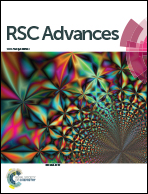Superior cycling stability and high rate capability of three-dimensional Zn/Cu foam electrodes for zinc-based alkaline batteries†
Abstract
Three-dimensional (3D) Zn/Cu foam electrodes are fabricated by pulse electro-deposition of zinc on copper foam and investigated as negative electrode materials for zinc-based alkaline batteries. Scanning electron microscopy (SEM) images show that epitaxially layered zinc crystals distribute uniformly on the 3D copper foam-like skeleton. A peak power density of 286 mW cm−2 and utilization of 92% (754 mA h g−1 at 200 mA cm−2) are obtained when the Zn/Cu foam electrodes are used in primary zinc/oxygen batteries and reveal high rate capability and material utilization of the 3D electrodes. To probe the rechargeability of the Zn/Cu foam electrodes, zinc/zinc quasi-symmetric cells are cycled under severe conditions, i.e., a discharge–charge current density of as high as 250 mA cm−2, 100% depth of discharge and without dendrite-suppressing additives that would otherwise suppress dendrite growth, yet the 3D Zn/Cu foam electrodes remain dendrite-free experienced 10 000 discharge–charge cycles. The specific capacity of the 3D Zn/Cu foam electrodes reaches up to 620 mA h g−1 after at least 9000 discharge–charge cycles in a prototype Zn/Ni battery, exhibiting the superior cycling stability of the 3D Zn/Cu foam electrodes.


 Please wait while we load your content...
Please wait while we load your content...